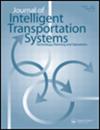Eco-friendly platooning operation algorithm of the electric vehicles
IF 2.8
3区 工程技术
Q3 TRANSPORTATION
Journal of Intelligent Transportation Systems
Pub Date : 2024-11-01
DOI:10.1080/15472450.2023.2209911
引用次数: 0
Abstract
Platooning is one of the promising technologies that maximizes the power efficiency of electric vehicles by decreasing the distances between the vehicles. Along with the development of autonomous driving technology, platooning is expected to be commercialized. Recent studies on the operation of platooning focused on power-efficient maintenance of platooning. However, power-efficient operation strategy is also needed for practical applications. Therefore, this study deals with platooning operations that can maximize the power efficiency of electric vehicles in various operational situations. In order to derive the operation method, a mathematical model structured with an objective function that minimizes power consumption is developed. To derive the solution of the mathematical model, a hybrid genetic algorithm is applied. The numerical experiments on four different operational situations are performed to verify the validity of the model and the solution procedure. The four situations consider overall situation that can happen during the platooning stage. The stages are formation, disassembly, join and breakaway of vehicles of platoon. Those four situations are decided upon since they can represent the general situation that can happen during platooning. As a result, the power-efficient driving patterns of electric vehicles are identified. After the development of electric and systematic technology, operational technology for platooning will collaborate for the further improvement. Therefore, throughout consideration of the formation of platooning, technology will expand the sustainability of technological development.
电动汽车的环保队列运行算法
通过缩短车辆之间的距离,使电动汽车的功率效率最大化,是一种很有前途的技术之一。随着自动驾驶技术的发展,队列驾驶有望实现商业化。近年来对车队运行的研究主要集中在车队的节能维护方面。然而,在实际应用中也需要高效节能的操作策略。因此,本研究涉及在各种运行情况下,使电动汽车的功率效率最大化的队列操作。为了推导出操作方法,建立了以功耗最小为目标函数的数学模型。为了得到数学模型的解,采用了混合遗传算法。通过四种不同工况下的数值实验,验证了模型和求解过程的有效性。这四种情况考虑了排队阶段可能发生的总体情况。车队的组建、拆卸、连接和分离是车队的组成阶段。这四种情况是确定的,因为它们可以代表在队列中可能发生的一般情况。从而确定了电动汽车的节能驾驶模式。在电力技术和系统技术发展之后,车队的操作技术将协同进一步完善。因此,全程考虑编队的形成,将扩大技术发展的可持续性。
本文章由计算机程序翻译,如有差异,请以英文原文为准。
求助全文
约1分钟内获得全文
求助全文
来源期刊
CiteScore
8.80
自引率
19.40%
发文量
51
审稿时长
15 months
期刊介绍:
The Journal of Intelligent Transportation Systems is devoted to scholarly research on the development, planning, management, operation and evaluation of intelligent transportation systems. Intelligent transportation systems are innovative solutions that address contemporary transportation problems. They are characterized by information, dynamic feedback and automation that allow people and goods to move efficiently. They encompass the full scope of information technologies used in transportation, including control, computation and communication, as well as the algorithms, databases, models and human interfaces. The emergence of these technologies as a new pathway for transportation is relatively new.
The Journal of Intelligent Transportation Systems is especially interested in research that leads to improved planning and operation of the transportation system through the application of new technologies. The journal is particularly interested in research that adds to the scientific understanding of the impacts that intelligent transportation systems can have on accessibility, congestion, pollution, safety, security, noise, and energy and resource consumption.
The journal is inter-disciplinary, and accepts work from fields of engineering, economics, planning, policy, business and management, as well as any other disciplines that contribute to the scientific understanding of intelligent transportation systems. The journal is also multi-modal, and accepts work on intelligent transportation for all forms of ground, air and water transportation. Example topics include the role of information systems in transportation, traffic flow and control, vehicle control, routing and scheduling, traveler response to dynamic information, planning for ITS innovations, evaluations of ITS field operational tests, ITS deployment experiences, automated highway systems, vehicle control systems, diffusion of ITS, and tools/software for analysis of ITS.

 求助内容:
求助内容: 应助结果提醒方式:
应助结果提醒方式:


